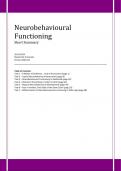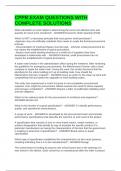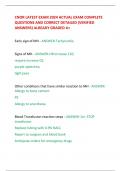Neurobehavioural
Functioning
Short Summary
26-10-2023
Maastricht University
Emma Leibbrand
Table of Contents
Task 1 – A Matter of Definition… And of Assessment (page 1)
Task 2 – Typical Neurobehavioural Assessment (page 8)
Task 3 – Neurobehavioural Functioning in Adulthood (page 20)
Task 4 – Attention! Everything is Under Control! (page 31)
Task 5 – Atypical Neurobehavioural Development (page 42)
Task 6 – Fear or Anxiety: Two Sides of the Same Coin? (page 55)
Task 7 – Differentiation of Neurobehavioural Functioning in Older Age (page 68)
, Task 1 – A Matter of Definition… And of Assessment
Categorical approach => The current system for diagnosing mental disorders (DSM-5). Relies on
diagnostic criteria to determine the presence or absence of disruptive or other abnormal behaviours.
Dimensional approach => Places such behaviours on a continuum of frequency and/or severity.
Symptomatology in the broader population exists as a continuum of severity, but in clinical practice,
disease is often seen as an all-or-nothing phenomenon.
Pros of Categorical Approach Pros of Dimensional Approach
Facilitates the decision making process. The Higher validity It reflects the true
presence of a diagnosis necessitates continuum of psychosis in the population +
treatment, while the lack of a diagnosis captures its high degree of heterogeneity +
negates the need of treatment. The variation.
diagnostic system provides a frame of It removes the loss of information that
reference for treating patients. occurs when continuous-level data are
Pro for research there is consistency organised + greater statistical power.
across studies (e.g. cut-off criteria), cost- It explains comorbidity + symptom overlap
effectiveness (costly and high-risk likely due to shared susceptibilities.
treatments are kept for those who cross Higher predictive power for clinical
thresholds), + it allows comparison of symptoms, treatment response and
studies resulting in more information. outcomes.
Improves diagnostic reliability There is
more agreement, consistency, and stability.
Improves communication among clinicians,
researchers and the lay community. It is a
good method for understanding a
particular syndrome.
Network approach => Explains why certain disorders may co-occur more than others. A mental
disorder can be viewed as a system of interacting symptoms.
Example = MDD symptoms are fatigue insomnia concentration problems sadness,
anhedonia and suicidal ideation.
Comorbidity = The presence of multiple disorders at the same time.
Patients diagnosed with multiple disorders have a poorer prognosis,
worse treatment outcomes and higher suicide rates.
Traditional view = Comorbid disorders are seen as different
disorders.
Network view = Disorders co-occur due to mutual interactions
among symptoms.
In other words, comorbidity arises when there are symptoms that
bridge two disorders, so-called bridge symptoms. These can spread
activation from one disorder to the other (figure 2).
Example = Bridge symptoms between GAD + MDD include
sleep problems, fatigue, concentration problems or psychomotor agitation.
1
,The prediction of psychopathology onset is one of the most important because many people
experience single symptoms, but only part of them develop a mental disorder.
Early warning signals indicate the upcoming onset of psychopathology for a specific patient.
Characteristics of group-level networks predict the future course of psychopathology.
Complex system => the conceptualisation of mental disorders as network of interacting symptoms.
One of the most important features of this is that they can display phase transitions.
Healthy => the individual shows no problems.
Early warning signs => displayed before a system reaches its tipping point.
o Example = people with high inertia levels in their emotion dynamics are more likely
to develop depression in 2.5 years.
Critical slowing down => before a transition occurs in the next step, the system slows down,
meaning it takes longer to recover from perturbations.
Phase transition => involves the transition from healthy to disordered state (IMPORTANT).
o For weakly connected symptom networks, negative external events (e.g. stressful
events) lead to a gradual increase in symptoms.
o For strongly connected networks, negative external events lead to a sudden shift
from a healthy to depressed state.
o Sheds light on the dimensional vs. categorical debate: weak networks may behave as
a continuum in response to stress, while strong networks may behave as categorical.
o This connectivity implies that people may have the same diagnosis, but that the
connectivity of the network structure would determine whether the disorder is a
continuum or a dimension for them.
Early Critical
Phase Disordered
Healthy warning slowing
transition state
signs down
Strong temporal emotion means => the state of an emotion at a certain time-point depends strongly
on the state of emotions at the previous time-point.
Temporal emotion networks of patients with MDD and psychosis are more strongly
connected than temporal emotion networks of healthy controls.
Research => The more densely connected temporal network structures, the more vulnerable
someone is to psychopathology.
o Example = higher levels of connectivity in patients with depression are associated
with worse outcomes at 2 year follow up.
The nature of symptoms also plays a role => the most central symptoms of a disorder were
more predictive of the onset of the disorder.
Centrality => how connected + clinically relevant a symptom is in
a network; it quantifies the importance of a node in a network.
Degree of centrality => the number of connections of a symptom.
High degree centrality (red node) the more of a risk
factor it is the more likely it will lead to the
development of other symptoms.
Difficult to find overview of which symptoms are more central
than others because studies differ in...
Variables used (e.g. MDD questionnaires).
Design (i.e. are cross sectional or time series).
2
, Samples (e.g. healthy, moderately depressed, severely depressed).
Network estimation methods
Taking these variables into account, the central symptoms of disorders include…
MDD = depressed mood, loss of interest / pleasure + fatigue.
PTSD = hypervigilance, impaired concentration, physiological reactivity to reminders of
trauma + sleep difficulty.
Standard The construct, e.g. schizophrenia = latent variable = common cause of its
symptoms.
Symptoms = effects of this latent variable / passive psychometric
indicators.
Interactions between symptoms gets no attention in research.
Assumption = environmental factors affect symptoms via the latent
disorder; the disorder mediates relation environment and symptoms.
o Problematic since individual symptoms are influenced by different
risk factors.
o E.g. childhood trauma is associated with hallucinations and
delusions but not with negative symptoms.
Network Solves this problematic assumption by representing individual differences
in vulnerability as differences in the connectivity of the network model.
In network models, mental disorders are not conceptualised as common
causes of symptoms, but as conditions that arise from the interaction
between symptoms.
More strongly connected networks higher level of interaction between
symptoms more activation of one another render system less
resilient.
Nodes = variables (risk factors).
Edge = seen between 2 nodes demonstrating their association
o Presence of an edge is suggestive of a causal relation BUT note:
nature + direction of this relation is not specified.
Green edges positive
connections
Red edges negative
connections
3
Functioning
Short Summary
26-10-2023
Maastricht University
Emma Leibbrand
Table of Contents
Task 1 – A Matter of Definition… And of Assessment (page 1)
Task 2 – Typical Neurobehavioural Assessment (page 8)
Task 3 – Neurobehavioural Functioning in Adulthood (page 20)
Task 4 – Attention! Everything is Under Control! (page 31)
Task 5 – Atypical Neurobehavioural Development (page 42)
Task 6 – Fear or Anxiety: Two Sides of the Same Coin? (page 55)
Task 7 – Differentiation of Neurobehavioural Functioning in Older Age (page 68)
, Task 1 – A Matter of Definition… And of Assessment
Categorical approach => The current system for diagnosing mental disorders (DSM-5). Relies on
diagnostic criteria to determine the presence or absence of disruptive or other abnormal behaviours.
Dimensional approach => Places such behaviours on a continuum of frequency and/or severity.
Symptomatology in the broader population exists as a continuum of severity, but in clinical practice,
disease is often seen as an all-or-nothing phenomenon.
Pros of Categorical Approach Pros of Dimensional Approach
Facilitates the decision making process. The Higher validity It reflects the true
presence of a diagnosis necessitates continuum of psychosis in the population +
treatment, while the lack of a diagnosis captures its high degree of heterogeneity +
negates the need of treatment. The variation.
diagnostic system provides a frame of It removes the loss of information that
reference for treating patients. occurs when continuous-level data are
Pro for research there is consistency organised + greater statistical power.
across studies (e.g. cut-off criteria), cost- It explains comorbidity + symptom overlap
effectiveness (costly and high-risk likely due to shared susceptibilities.
treatments are kept for those who cross Higher predictive power for clinical
thresholds), + it allows comparison of symptoms, treatment response and
studies resulting in more information. outcomes.
Improves diagnostic reliability There is
more agreement, consistency, and stability.
Improves communication among clinicians,
researchers and the lay community. It is a
good method for understanding a
particular syndrome.
Network approach => Explains why certain disorders may co-occur more than others. A mental
disorder can be viewed as a system of interacting symptoms.
Example = MDD symptoms are fatigue insomnia concentration problems sadness,
anhedonia and suicidal ideation.
Comorbidity = The presence of multiple disorders at the same time.
Patients diagnosed with multiple disorders have a poorer prognosis,
worse treatment outcomes and higher suicide rates.
Traditional view = Comorbid disorders are seen as different
disorders.
Network view = Disorders co-occur due to mutual interactions
among symptoms.
In other words, comorbidity arises when there are symptoms that
bridge two disorders, so-called bridge symptoms. These can spread
activation from one disorder to the other (figure 2).
Example = Bridge symptoms between GAD + MDD include
sleep problems, fatigue, concentration problems or psychomotor agitation.
1
,The prediction of psychopathology onset is one of the most important because many people
experience single symptoms, but only part of them develop a mental disorder.
Early warning signals indicate the upcoming onset of psychopathology for a specific patient.
Characteristics of group-level networks predict the future course of psychopathology.
Complex system => the conceptualisation of mental disorders as network of interacting symptoms.
One of the most important features of this is that they can display phase transitions.
Healthy => the individual shows no problems.
Early warning signs => displayed before a system reaches its tipping point.
o Example = people with high inertia levels in their emotion dynamics are more likely
to develop depression in 2.5 years.
Critical slowing down => before a transition occurs in the next step, the system slows down,
meaning it takes longer to recover from perturbations.
Phase transition => involves the transition from healthy to disordered state (IMPORTANT).
o For weakly connected symptom networks, negative external events (e.g. stressful
events) lead to a gradual increase in symptoms.
o For strongly connected networks, negative external events lead to a sudden shift
from a healthy to depressed state.
o Sheds light on the dimensional vs. categorical debate: weak networks may behave as
a continuum in response to stress, while strong networks may behave as categorical.
o This connectivity implies that people may have the same diagnosis, but that the
connectivity of the network structure would determine whether the disorder is a
continuum or a dimension for them.
Early Critical
Phase Disordered
Healthy warning slowing
transition state
signs down
Strong temporal emotion means => the state of an emotion at a certain time-point depends strongly
on the state of emotions at the previous time-point.
Temporal emotion networks of patients with MDD and psychosis are more strongly
connected than temporal emotion networks of healthy controls.
Research => The more densely connected temporal network structures, the more vulnerable
someone is to psychopathology.
o Example = higher levels of connectivity in patients with depression are associated
with worse outcomes at 2 year follow up.
The nature of symptoms also plays a role => the most central symptoms of a disorder were
more predictive of the onset of the disorder.
Centrality => how connected + clinically relevant a symptom is in
a network; it quantifies the importance of a node in a network.
Degree of centrality => the number of connections of a symptom.
High degree centrality (red node) the more of a risk
factor it is the more likely it will lead to the
development of other symptoms.
Difficult to find overview of which symptoms are more central
than others because studies differ in...
Variables used (e.g. MDD questionnaires).
Design (i.e. are cross sectional or time series).
2
, Samples (e.g. healthy, moderately depressed, severely depressed).
Network estimation methods
Taking these variables into account, the central symptoms of disorders include…
MDD = depressed mood, loss of interest / pleasure + fatigue.
PTSD = hypervigilance, impaired concentration, physiological reactivity to reminders of
trauma + sleep difficulty.
Standard The construct, e.g. schizophrenia = latent variable = common cause of its
symptoms.
Symptoms = effects of this latent variable / passive psychometric
indicators.
Interactions between symptoms gets no attention in research.
Assumption = environmental factors affect symptoms via the latent
disorder; the disorder mediates relation environment and symptoms.
o Problematic since individual symptoms are influenced by different
risk factors.
o E.g. childhood trauma is associated with hallucinations and
delusions but not with negative symptoms.
Network Solves this problematic assumption by representing individual differences
in vulnerability as differences in the connectivity of the network model.
In network models, mental disorders are not conceptualised as common
causes of symptoms, but as conditions that arise from the interaction
between symptoms.
More strongly connected networks higher level of interaction between
symptoms more activation of one another render system less
resilient.
Nodes = variables (risk factors).
Edge = seen between 2 nodes demonstrating their association
o Presence of an edge is suggestive of a causal relation BUT note:
nature + direction of this relation is not specified.
Green edges positive
connections
Red edges negative
connections
3












